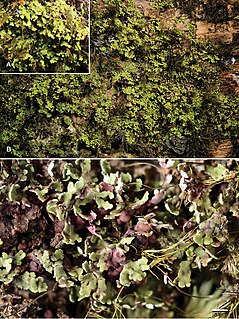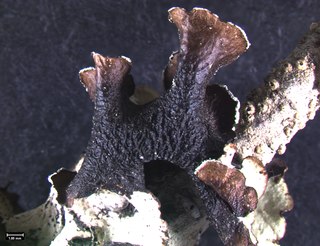
Krogia is a genus of corticolous lichens in the family Ramalinaceae. It occurs in tropical humid forests and rainforests. The genus was circumscribed by Norwegian lichenologist Einar Timdal in 2002, with Krogia coralloides assigned as the type species.
Clypeopyrenis is a genus of lichen-forming fungi in the family Pyrenulaceae. The genus was circumscribed in 1991 by Dutch lichenologist André Aptroot, with Clypeopyrenis microsperma assigned as the type species. This lichen, originally described from material collected in Costa Rica, is also found in the Caribbean and South America. Clypeopyrenis porinoides was added to the genus in 2011; it was discovered in Costa Rica, close to the type locality of the type species.
Harpidium is a genus of lichen-forming fungi in the family Harpidiaceae. The genus contains three species. Harpidium was circumscribed in 1855 by German lichenologist Gustav Wilhelm Körber, with Harpidium rutilans assigned as the type species.
Acarospora janae is a species of lichen in the Acarosporaceae family. Described as new to science in 2011, it is known only from New Mexico and Colorado in the United States, where it grows on siliceous rock.
André Aptroot is a Dutch mycologist and lichenologist.
Amandinea maritima is a species of corticolous (bark-dwelling), crustose lichen in the family Caliciaceae. Found in Europe, it was described as new to science in 2011.
Calopadia editae is a species of lichen in the family Pilocarpaceae. Described as new to science in 2011, the species is named in honor of Hungarian lichenologist Edit Farkas.
Xanthomendoza rosmarieae is a species of lichen in the family Teloschistaceae. Known only from the type locality in Sussex County, Delaware, it was described as new to science in 2011. It is named after the Swiss lichenologist Rosmarie Honegger.
Fellhanera borbonica is a species of lichen in the family Pilocarpaceae. It was described as new to science in 2011. Found in Réunion, the specific epithet borbonica denotes the original name for Réunion, or Île Bourbon.
Echinoplaca pernambucensis is a species of lichen in the family Gomphillaceae. It was described as new to science in 2011. It is found in Brazil.
Relicina colombiana is a species of lichen in the family Parmeliaceae. Known from Colombia, it was described as new to science in 2011.
Sagenidiopsis isidiata is a species of lichen in the family Arthoniaceae. Known from Guatemala, it was described as new to science in 2011.

Platismatia wheeleri is a species of lichen in the family Parmeliaceae. Known from western North America, it was described as new to science in 2011.
Lempholemma corticola is a species of lichen in the family Lecanoraceae. Known from Greece, it was described as new to science in 2011.
Chiodecton pustuliferum is a species of lichen in the family Roccellaceae. Found in Madagascar, it was described as new to science in 2011.
Lecanora mugambii is a species of crustose lichen in the family Lecanoraceae. Found in Kenya, it was described as new to science in 2011.
Lecanora printzenii is a species of crustose lichen in the family Lecanoraceae. Known from Spain, it was described as new to science in 2011.
Helge Thorsten Lumbsch is a German-born lichenologist living in the United States. His research interests include the phylogeny, taxonomy, and phylogeography of lichen-forming fungi; lichen diversity; lichen chemistry and chemotaxonomy. He is the Associate Curator and Head of Cryptogams and Chair of the Department of Botany at the Field Museum of Natural History.
Clypeopyrenis porinoides is a species of corticolous (bark-loving) lichen in the family Pyrenulaceae. Found in Costa Rica, it was described as new to science in 2011 by Harald Komposch, Jesús Ernesto Hernández Maldonado, and Dania Rosabal. The type specimen was found near the Las Cruces Biological Station in Sán Vito de Coto Brus at an altitude of 1,200 m (3,900 ft). Here the lichen was growing on trunks and undergrowth in a primary forest. The specific epithet porinoides refers to its resemblance to species of Porina.
Verrucaria rhizicola is a rare species of corticolous (bark-dwelling), aquatic, crustose lichen in the family Verrucariaceae. Found in France, it was formally described as a new species in 2011 by lichenologists André Aptroot and Holger Thüs. The type specimen was collected by the first author from the Forêt de Boulogne (Pas-de-Calais). There, the lichen was growing on the roots of common alder. It is only known from the type collection. The species epithet rhizicola refers to its growth on roots. The roots holding the lichen are located along a stream in a temperate forest, and as such, the lichen is regularly immersed in fresh water. Verrucaria rhizicola is one of about 20 corticolous species in genus Verrucaria. In addition to its uncommon habitat, other unique characteristics of this species are the prominent, minute, shiny ascomata that have a distinctive dimidiate involucrellum, and the asymmetrically kidney-shaped ascospores.

